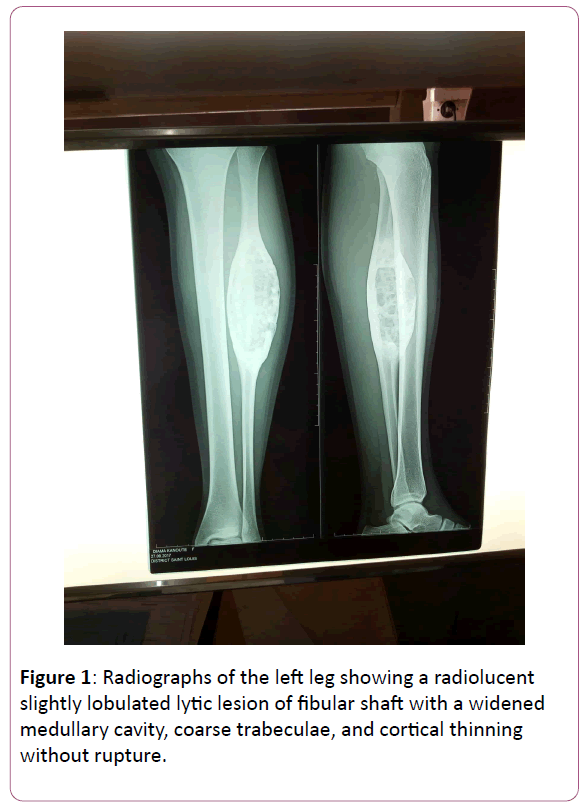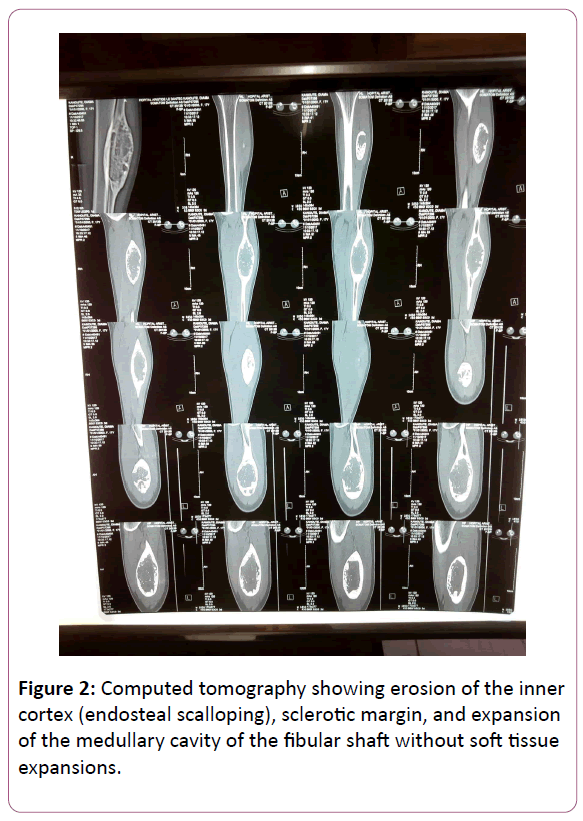Chondromyxoid Fibroma of the Fibular Shaft: A Case Report

A chondromyxoid fibroma (CMF) is an extremely rare benign tumor of long bones. It usually affects the metaphyseal region of long bones, particularly near the growth plate of the proximal tibia. We report the case of fibular shaft localization. A chondromyxoid fibroma (CMF) is an extremely rare benign tumor of long bones. It usually affects the metaphyseal region of long bones, particularly near the growth plate of the proximal tibia. We report the case of fibular shaft localization. Miss D.K, a 17-year-old girl consulted for a 2-month history of sport trauma. She presented with progressive and slightly painful swelling of the lateral aspect of her left leg. She was previously healthy, and additional signs of illness could not be found. Physical examination showed a hard, firm, tender swelling on deep palpation and adherent to the fibula of approximately 6 centimeters in length. It was located on the lateral middle third of the left leg. Neither skin lesions nor inguinal lymph nodes were found. No other abnormalities were revealed by the full systemic review. The X-ray of the leg showed the fibular shaft localization of the tumor. The radiographic appearances were those of a sharply marginated, lytic lesion in an eccentric fashion, cortical expansion and a sclerotic rim Figure 1.

Computed Tomography scans showed a large lesion of lytic features and extended into the cortical bone, which appeared thinner and unruptured. The presumptive CT diagnosis was an enchondroma with no signs of malignancy Figure 2.

Chondromyxoid fibroma is the least commonly occurring bone tumor, accounting for approximately 0.5% of all biopsied primary bone tumors and 2% of benign tumors. Jaffe and Lichtenstein first described the condition. As reported in our study and through literature review, the symptomatology had no particularity compared to other benign bone tumors. Clinically, the main symptoms are pain, swelling or tenderness and pressure. In our case, the age of predilection of this tumor was in the second decade of life. There is a controversial sex predilection. Schajowicz and Gallardo as well as Rahimi et al. and Debra et al. in their respective series found no significative differences between the two sexes. Hence, there is no relationship between sex and CMF. Chondromyxoid fibroma is a benign tumor usually affecting the metaphyseal region of long bones of patients in their second decade of life. Its definitive diagnosis is made by histological examination. The preferred treatment, where possible, is an en bloc excision with tumor-free margins.
Best Regards,
Joseph Kent
Journal Manager
Journal of Trauma & Orhopaedic Nursing